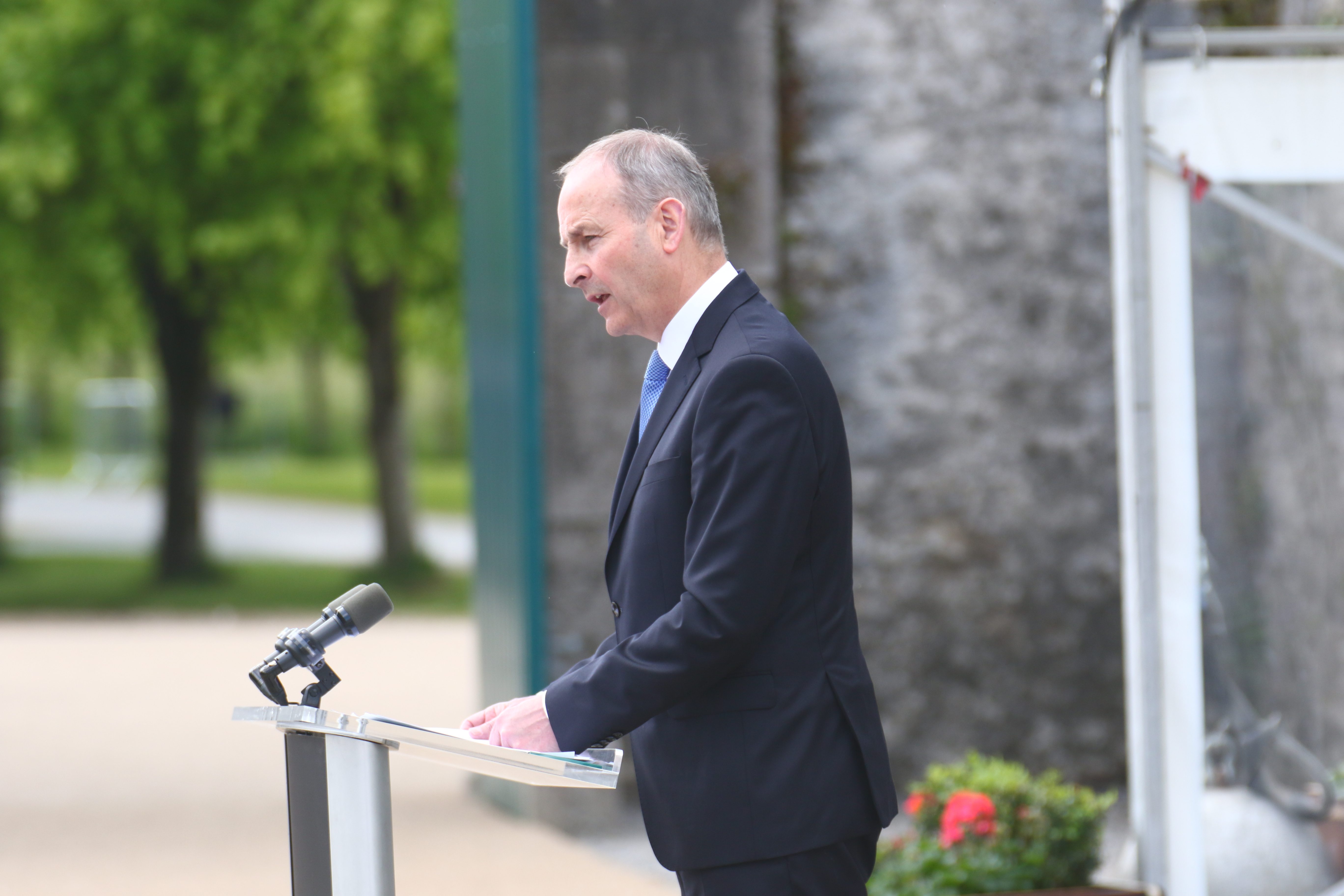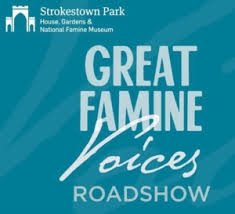Great Famine Voices San Francisco (25:38) explores the history of the city’s Irish community on a tour led by Myles Dungan (RTÉ Radio 1, The History Show) and Glen Gendzel (San Jose State University). They recount the legacy of Famine Irish emigrants in building the city as well as the impact of the San Francisco earthquake and fire of 1906 on its landmarks such as the Flood Building, St. Patrick’s Church, and Old St. Mary’s Cathedral. They provide an unflinching account of the role of Irish emigrants such as Denis Kearney and Matthew Noonan in fomenting anti-Chinese racism, and pay tribute to the inspirational figure of Kate Kennedy, an early public school teacher and labour activist whose family had fled from famine-stricken Ireland.
From Strokestown to San Diego: In The Midst of Plenty (31:28) brings together the founder and artistic director of Enchanted Croi Theatre Anne-Marie O’Sullivan and composer-lyricist Amy Day who offer a behind the scenes look at the creative process and their inspirations from the Strokestown Park Archive for their spell-binding new production with its hauntingly beautiful and heartbreaking melodies resonant with the fears of eviction, family breakdown, and inconsolable loss in the past and present. Set in 1847 at the height of the Great Hunger, it tells the story of the desperate lengths the starving tenants on the Strokestown estate in Roscommon went to in order to survive, including betrayal, deceit, and violence, when confronted with eviction and mass-migration. The film features audience reaction from the Irish Outreach Center in San Diego.
In From Strokestown to London (25:27) acclaimed poet and performance artist Cherry Smyth counterpoints her impressions of female Famine Irish immigrants in London in the 1840s with her recollections of visiting the National Famine Museum, Strokestown Park, which helped inspire her to create Famished (Pindrop Press, 2019). She brings viewers on an evocative and spell-binding journey from famine-stricken rural Ireland to the heart of the British Empire at the height of the Great Hunger. The film weaves together candid reflections, evocative verse, traditional lyric and recovered voices from the 1840s which convey and interlayer the plight of women with the fate of Famine migrants such as the 1,490 from Strokestown who crossed the Atlantic on “coffin ships”. Smyth collaborates with composer Ed Bennett and vocalist Lauren Kinsella for the performance as well as filmmaker Louise Boer.
In the Midst of Plenty (22:04) has been released by The National Famine Museum, Strokestown Park and Irish Heritage Trust in collaboration with Enchanted Croi Theatre to mark the 2023 National Famine Commemoration. Set in 1847 at the height of the Great Hunger, it tells the story of the desperate lengths the starving tenants on the Strokestown estate in Roscommon went to in order to survive, including betrayal, deceit, and violence, when confronted with eviction and mass-migration. The film showcases some spelling-binding performances from In the Midst of Plenty and explores how it finds inspiration in petitions from the dispossessed and historical records in the Strokestown Park Famine Archive that are transformed into hauntingly beautiful and heartbreaking melodies resonant with the fears of eviction, family breakdown, and inconsolable loss in the past and present.
Ira Aldridge: African Tragedian in Ireland (35:38) tells the story of one of the most remarkable Black Abolitionists in Famine Ireland. Ira Aldridge was unique as an African-American actor and abolitionist who performed and toured in Ireland at the height of the Great Hunger in 1847-1848. His powerful and moving dramatic performances raised awareness of enslavement and persecution for many years, though he remains little known in the country of his birth. The film is made in collaboration with Professor Christine Kinealy from the African American Irish Diaspora Network and Ireland’s Great Hunger Institute at Quinnipiac University.
Famine Lessons: Ireland and European Union Aid, Education, and Heritage (24:52) marks the fiftieth anniversary of Ireland’s accession to the EU. The film explores and raises awareness about key EU funded programmes in Ireland such as the European Heritage Awards / Europa Nostra Awards of which the founder of the National Famine Museum, Jim Callery, is a recipient, as well as Erasmus + and the life-saving Enhanced Responses to Nutrition Emergencies (ERNE) project. The film is made in collaboration with Concern Worldwide and with funding from the Department of Foreign Affairs Communicating Europe Initiative 2023.
The Famine Irish in New Brunswick (36:53) tells the little known story of the 16,000 emigrants who fled from famine-stricken Ireland in 1847 to the British North American colony (now Canadian province) of New Brunswick. Two thousand of them perished at quarantine stations such as Partridge Island (Saint John), Middle Island (Miramichi), and Hospital Island (Saint Andrews). The film pays tribute to them and the self-sacrifice of their caregivers, such as Dr James Patrick Collins who lost his life on Partridge Island, and Dr John Vondy who died caring for Irish emigrants on Middle Island. It offers a rare glimpse of Partridge Island where six hundred Irish migrants lie buried on a site that has long been closed to the public.

The Famine Irish in Glasgow (34:58) features Professor Sir Tom Devine, the leading historian on the Irish in Scotland. He reflects on the impact and legacy of the Famine Irish migration to Glasgow in 1847 as well as his own grandparents’ story of relocation from Ulster to Scotland in the later nineteenth century. The film also explores how Celtic Football Club was established to help alleviate the poverty of Famine Irish emigrants and their descendants.
In William Wells Brown: Black Abolitionist in Famine Ireland (30:03), Professor Christine Kinealy (Ireland’s Great Hunger Institute, Quinnipiac University, African American Irish Diaspora Network) explores Brown’s little known visit to Dublin in August 1849. As a “self-emancipated slave”, he delivered an Abolitionist lecture only days after Queen Victoria – later denigrated as the “Famine Queen” – had embarked on her own tour of the hunger stricken country. Lenwood “Leni” Sloan (African American Irish Diaspora Network) reprises Wells Brown’s most evocative utterances while he was in Ireland and afterwards. Although he was only in Ireland for a relatively short period, William Wells Brown found his visit — like Frederick Douglass before him — foundational and transformative for his development as an Abolitionist and activist abroad.
Great Famine Voices Hamilton, Ontario (35:49) shares stories from the city’s descendants of Famine emigrants and members of the Irish Canadian Club of Hamilton near the location of one of Canada’s forgotten Irish burial grounds in Burlington Heights. They offer moving accounts of the growth of Hamilton’s Irish community from the tragic year of 1847 and the establishment of its close-knit Irish Canadian Club. The film is a National Famine Museum, Strokestown Park, Irish Heritage Trust and Canada Ireland Foundation co-production.
In Tracing Strokestown Famine Emigrants on the Welland Canal (33:58), Professor Mark McGowan from the University of Toronto follows in the footsteps of some of the 1,490 assisted migrants from the Strokestown Park estate (now home of the National Famine Museum) in 1847 who resettled in Canada’s Niagara region to find work on the Welland Canal. He uses newly discovered correspondence from the Strokestown Park Famine Archive between the landlord Major Denis Mahon and his agent John Ross Mahon to explain how the emigration scheme was planned. He also suggests that the horrific fate of former tenants who crossed the Atlantic on board coffin ships such as the Virginius and Naomi — where almost half of them perished — was less attributable to the landlord than previously thought, though he was assassinated shortly thereafter in retribution. In tracing their fate, the film brings to life the tragic and uplifting stories of Strokestown’s Famine emigrants who fled Ireland in 1847 to resettle on the Welland Canal.
The National Famine Museum, Strokestown Park (6:32) is being launched by the Irish Heritage Trust to mark Ireland’s National Famine Commemoration Day, held in Strokestown Park on 15 May. The film provides a behind the scenes look at the National Famine Museum’s redevelopment where the story of Strokestown’s tragic past is brought to life through a captivating audio-visual exhibition.
The National Famine Museum, Strokestown Park showcases the Museum’s new state-of-the-art facilities, interactive displays, and evocative archival records that offer invaluable insights into the parallel lives of the cottiers, tenants and landlords who experienced the Great Irish Famine. The film explores the Famine migration from Strokestown in 1847 as a painful legacy that defines an educational mission and outreach activities such as Great Famine Voices, the National Famine Way, and the Famine Summer School to reconnect with Irish Diaspora communities.
The National Famine Commemoration Day ceremony was broadcast live from Strokestown Park on the RTÉ News channel on Sunday 15 May at 12pm Irish time.






Great Famine Voices New York State (59:08) shares the stories of Irish-American New Yorkers and the descendants of Famine Emigrants from the Irish American Heritage Museum in Albany, the Irish Cultural Center of the Mohawk Valley in Utica, the Erie Canal Museum and Le Moyne College in Syracuse, and the Buffalo Irish Center. They recall how their ancestors left Ireland during the Great Hunger and afterwards to start new lives along the Erie Canal. The film is dedicated to Eileen Patricia McMahon Zogby in whose name an annual Irish lecture has been established at Le Moyne College in Syracuse. Her discovery that her ancestors fell victim to the Great Hunger inspired her sense of social justice to learn lessons for today as part of her enduring legacy.
The Famine Irish in Chicago (42:02) features Professor Sean Farrell who examines some of the ways that Famine Irish emigrants helped build modern Chicago and Illinois in the 1840s and 1850. He explores how the Great Hunger shaped the outlook of prominent Irish-Americans, such as Mary Harris, or Mother Jones, to fight for fairness and greater social justice on the anniversary of her birth.

